2016 NISSAN ROGUE turn signal
[x] Cancel search: turn signalPage 358 of 478

TIRE PRESSURE MONITORING
SYSTEM (TPMS)
This vehicle is equipped with TPMS. It monitors
tire pressure of all tires except the spare. When
the low tire pressure warning light is lit, and the
“Tire Pressure Low — Add Air” (“Tire Pressure
Low — Visit Dealer” for vehicles equipped with
run-flat tires) warning appears in the vehicle in-
formation display, one or more of your tires is
significantly under-inflated. If equipped, the sys-
tem also displays pressure of all tires (except the
spare tire) on the display screen by sending a
signal from a sensor that is installed in each
wheel. If the vehicle is being driven with low tire
pressure, the TPMS will activate and warn you of
it by the low tire pressure warning light. This
system will activate only when the vehicle is
driven at speeds above 16 mph (25 km/h). For
additional information, refer to “Warning lights,
indicator lights and audible reminders” in the
“Instruments and controls” section and “Tire
Pressure Monitoring System (TPMS)” in the
“Starting and driving” section of this manual.
WARNING
●Radio waves could adversely affect elec-
tric medical equipment. Those who use a
pacemaker should contact the electric
medical equipment manufacturer for the
possible influences before use.
●If the low tire pressure warning light illu-
minates while driving, avoid sudden
steering maneuvers or abrupt braking,
reduce vehicle speed, pull off the road to
a safe location and stop the vehicle as
soon as possible. Driving with under-
inflated tires may permanently damage
the tires and increase the likelihood of
tire failure. Serious vehicle damage could
occur and may lead to an accident and
could result in serious personal injury.
Check the tire pressure for all four tires.
Adjust the tire pressure to the recom-
mended COLD tire pressure shown on
the Tire and Loading Information label to
turn the low tire pressure warning light
OFF. If the light still illuminates while
driving after adjusting the tire pressure,
a tire may be flat or the TPMS may be
malfunctioning. If you have a flat tire,
replace it with a spare tire as soon as
possible. If no tire is flat and all tires are
properly inflated, have the vehicle
checked. It is recommended you visit a
NISSAN dealer for this service.
● Since the spare tire is not equipped with
the TPMS, when mounted or a wheel is
replaced, tire pressure will not be indi-
cated, the TPMS will not function and
the low tire pressure warning light will
flash for approximately 1 minute. The
light will remain on after 1 minute. Have
your tires replaced and/or TPMS sys-
tem reset as soon as possible. It is rec-
ommended you visit a NISSAN dealer
for these services.
● Replacing tires with those not originally
specified by NISSAN could affect the
proper operation of the TPMS.
● Do not inject any tire liquid or aerosol
tire sealant into the tires, as this may
cause a malfunction of the tire pressure
sensors.
FLAT TIRE
In case of emergency6-3
Page 359 of 478
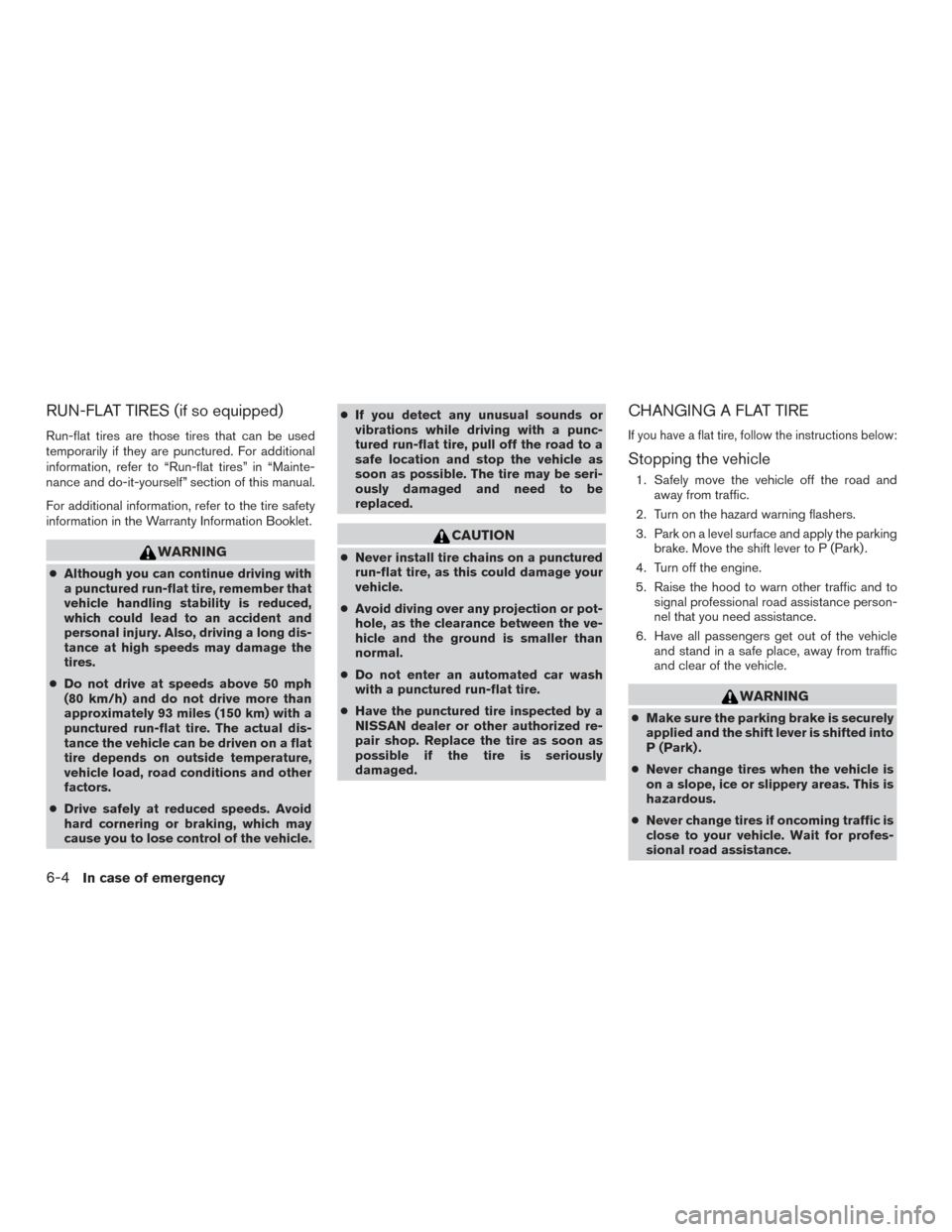
RUN-FLAT TIRES (if so equipped)
Run-flat tires are those tires that can be used
temporarily if they are punctured. For additional
information, refer to “Run-flat tires” in “Mainte-
nance and do-it-yourself” section of this manual.
For additional information, refer to the tire safety
information in the Warranty Information Booklet.
WARNING
●Although you can continue driving with
a punctured run-flat tire, remember that
vehicle handling stability is reduced,
which could lead to an accident and
personal injury. Also, driving a long dis-
tance at high speeds may damage the
tires.
● Do not drive at speeds above 50 mph
(80 km/h) and do not drive more than
approximately 93 miles (150 km) with a
punctured run-flat tire. The actual dis-
tance the vehicle can be driven on a flat
tire depends on outside temperature,
vehicle load, road conditions and other
factors.
● Drive safely at reduced speeds. Avoid
hard cornering or braking, which may
cause you to lose control of the vehicle. ●
If you detect any unusual sounds or
vibrations while driving with a punc-
tured run-flat tire, pull off the road to a
safe location and stop the vehicle as
soon as possible. The tire may be seri-
ously damaged and need to be
replaced.
CAUTION
● Never install tire chains on a punctured
run-flat tire, as this could damage your
vehicle.
● Avoid diving over any projection or pot-
hole, as the clearance between the ve-
hicle and the ground is smaller than
normal.
● Do not enter an automated car wash
with a punctured run-flat tire.
● Have the punctured tire inspected by a
NISSAN dealer or other authorized re-
pair shop. Replace the tire as soon as
possible if the tire is seriously
damaged.
CHANGING A FLAT TIRE
If you have a flat tire, follow the instructions below:
Stopping the vehicle
1. Safely move the vehicle off the road and away from traffic.
2. Turn on the hazard warning flashers.
3. Park on a level surface and apply the parking brake. Move the shift lever to P (Park) .
4. Turn off the engine.
5. Raise the hood to warn other traffic and to signal professional road assistance person-
nel that you need assistance.
6. Have all passengers get out of the vehicle and stand in a safe place, away from traffic
and clear of the vehicle.
WARNING
●Make sure the parking brake is securely
applied and the shift lever is shifted into
P (Park) .
● Never change tires when the vehicle is
on a slope, ice or slippery areas. This is
hazardous.
● Never change tires if oncoming traffic is
close to your vehicle. Wait for profes-
sional road assistance.
6-4In case of emergency
Page 380 of 478
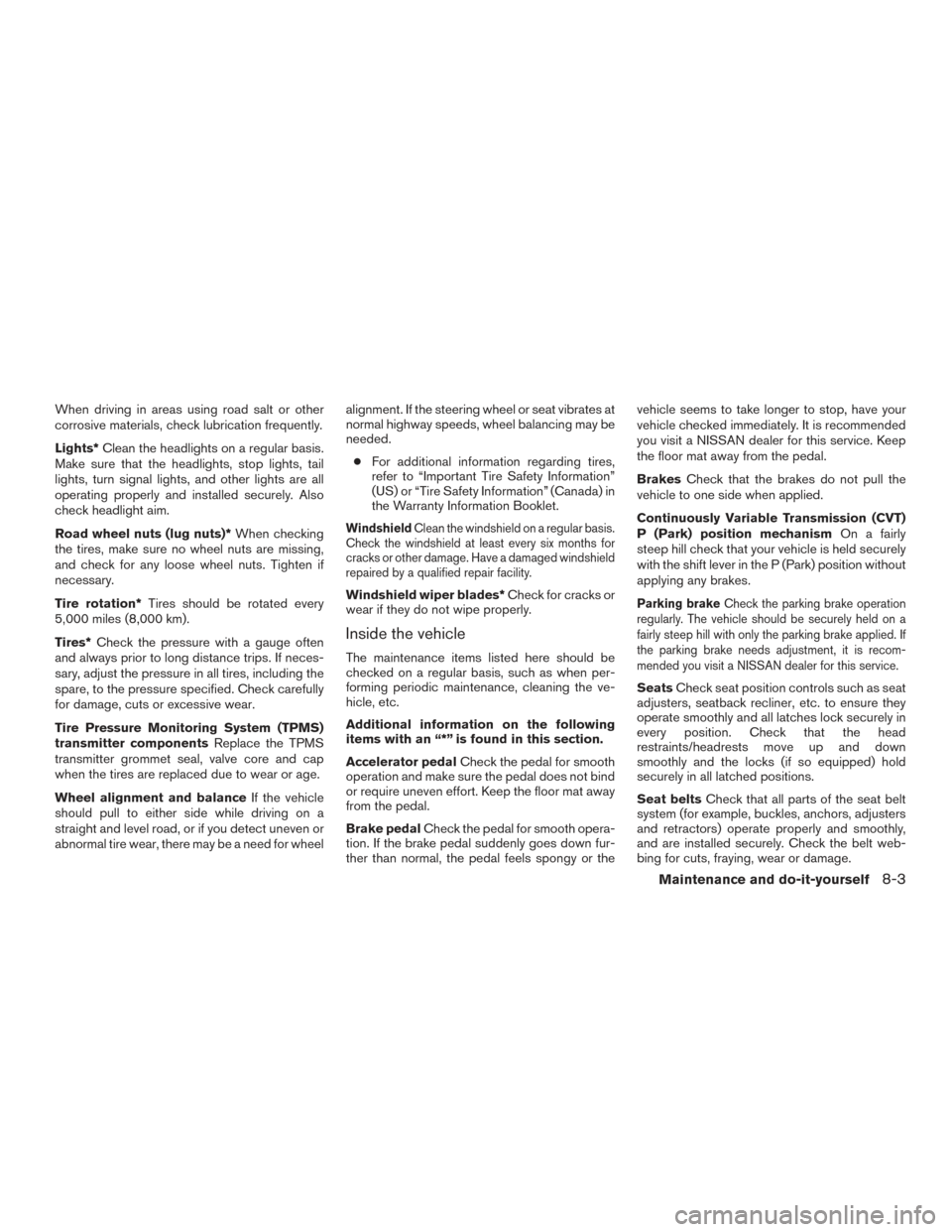
When driving in areas using road salt or other
corrosive materials, check lubrication frequently.
Lights*Clean the headlights on a regular basis.
Make sure that the headlights, stop lights, tail
lights, turn signal lights, and other lights are all
operating properly and installed securely. Also
check headlight aim.
Road wheel nuts (lug nuts)* When checking
the tires, make sure no wheel nuts are missing,
and check for any loose wheel nuts. Tighten if
necessary.
Tire rotation* Tires should be rotated every
5,000 miles (8,000 km).
Tires* Check the pressure with a gauge often
and always prior to long distance trips. If neces-
sary, adjust the pressure in all tires, including the
spare, to the pressure specified. Check carefully
for damage, cuts or excessive wear.
Tire Pressure Monitoring System (TPMS)
transmitter components Replace the TPMS
transmitter grommet seal, valve core and cap
when the tires are replaced due to wear or age.
Wheel alignment and balance If the vehicle
should pull to either side while driving on a
straight and level road, or if you detect uneven or
abnormal tire wear, there may be a need for wheel alignment. If the steering wheel or seat vibrates at
normal highway speeds, wheel balancing may be
needed.
● For additional information regarding tires,
refer to “Important Tire Safety Information”
(US) or “Tire Safety Information” (Canada) in
the Warranty Information Booklet.
Windshield Clean the windshield on a regular basis.
Check the windshield at least every six months for
cracks or other damage. Have a damaged windshield
repaired by a qualified repair facility.
Windshield wiper blades* Check for cracks or
wear if they do not wipe properly.
Inside the vehicle
The maintenance items listed here should be
checked on a regular basis, such as when per-
forming periodic maintenance, cleaning the ve-
hicle, etc.
Additional information on the following
items with an “*” is found in this section.
Accelerator pedal Check the pedal for smooth
operation and make sure the pedal does not bind
or require uneven effort. Keep the floor mat away
from the pedal.
Brake pedal Check the pedal for smooth opera-
tion. If the brake pedal suddenly goes down fur-
ther than normal, the pedal feels spongy or the vehicle seems to take longer to stop, have your
vehicle checked immediately. It is recommended
you visit a NISSAN dealer for this service. Keep
the floor mat away from the pedal.
Brakes
Check that the brakes do not pull the
vehicle to one side when applied.
Continuously Variable Transmission (CVT)
P (Park) position mechanism On a fairly
steep hill check that your vehicle is held securely
with the shift lever in the P (Park) position without
applying any brakes.
Parking brake Check the parking brake operation
regularly. The vehicle should be securely held on a
fairly steep hill with only the parking brake applied. If
the parking brake needs adjustment, it is recom-
mended you visit a NISSAN dealer for this service.
Seats Check seat position controls such as seat
adjusters, seatback recliner, etc. to ensure they
operate smoothly and all latches lock securely in
every position. Check that the head
restraints/headrests move up and down
smoothly and the locks (if so equipped) hold
securely in all latched positions.
Seat belts Check that all parts of the seat belt
system (for example, buckles, anchors, adjusters
and retractors) operate properly and smoothly,
and are installed securely. Check the belt web-
bing for cuts, fraying, wear or damage.
Maintenance and do-it-yourself8-3
Page 407 of 478
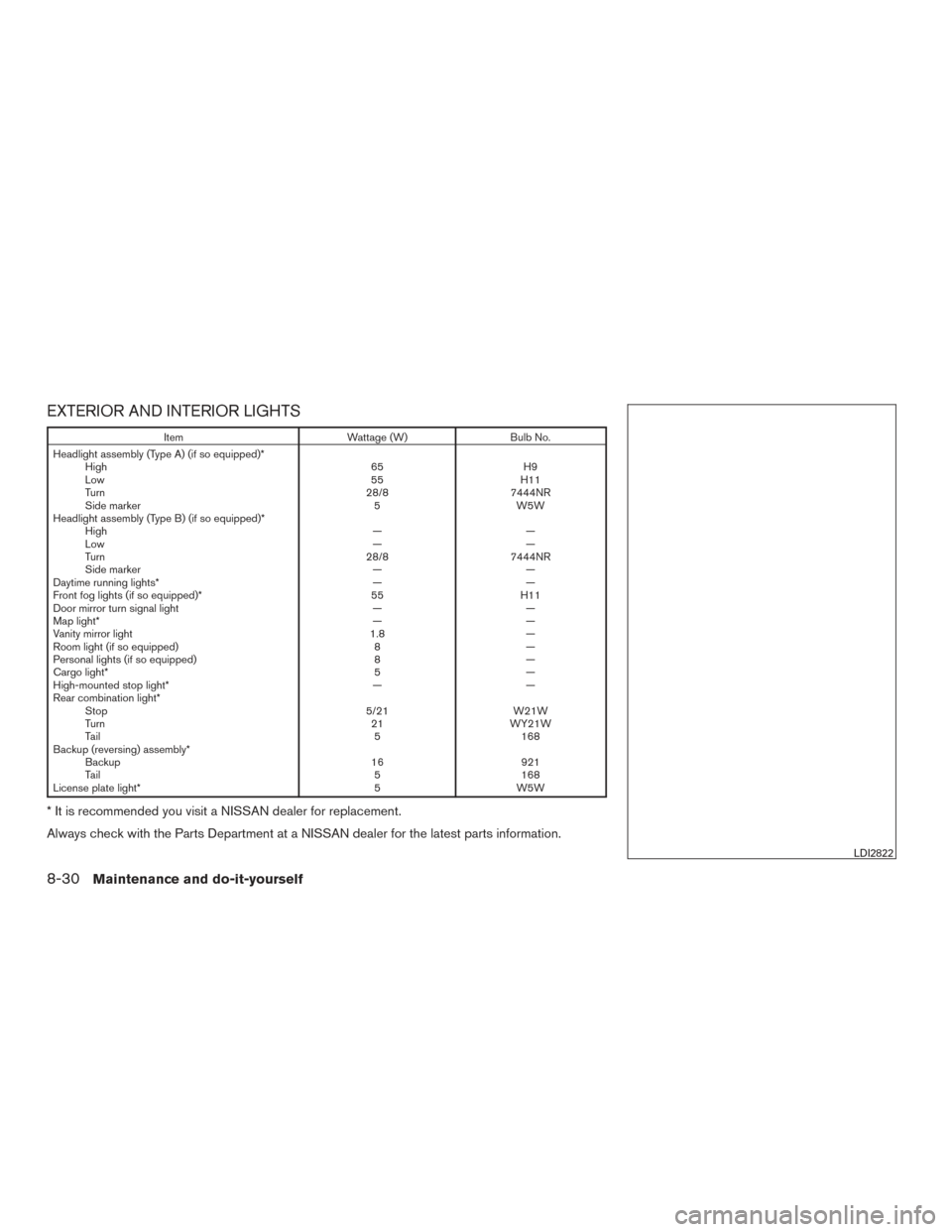
EXTERIOR AND INTERIOR LIGHTS
ItemWattage (W)Bulb No.
Headlight assembly (Type A) (if so equipped)* High 65H9
Low 55H11
Turn 28/87444NR
Side marker 5W5W
Headlight assembly (Type B) (if so equipped)* High ——
Low ——
Turn 28/87444NR
Side marker ——
Daytime running lights* ——
Front fog lights (if so equipped)* 55H11
Door mirror turn signal light ——
Map light* ——
Vanity mirror light 1.8—
Room light (if so equipped) 8—
Personal lights (if so equipped) 8—
Cargo light* 5—
High-mounted stop light* ——
Rear combination light* Stop 5/21W21W
Turn 21WY21W
Tail 5168
Backup (reversing) assembly* Backup 16921
Tail 5168
License plate light* 5W5W
* It is recommended you visit a NISSAN dealer for replacement.
Always check with the Parts Department at a NISSAN dealer for the latest parts information.
LDI2822
8-30Maintenance and do-it-yourself
Page 408 of 478
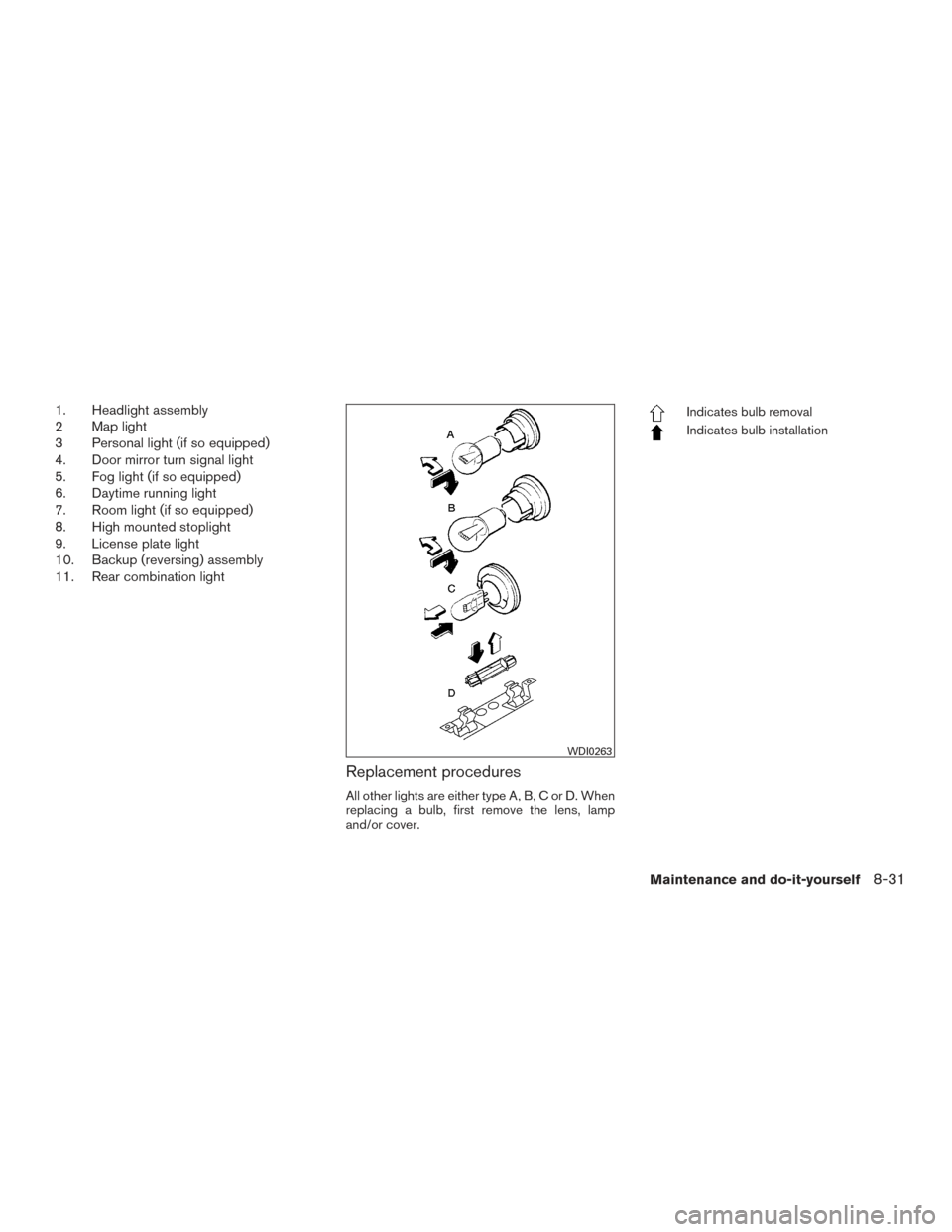
1. Headlight assembly
2 Map light
3 Personal light (if so equipped)
4. Door mirror turn signal light
5. Fog light (if so equipped)
6. Daytime running light
7. Room light (if so equipped)
8. High mounted stoplight
9. License plate light
10. Backup (reversing) assembly
11. Rear combination light
Replacement procedures
All other lights are either type A, B, C or D. When
replacing a bulb, first remove the lens, lamp
and/or cover.
Indicates bulb removal
Indicates bulb installation
WDI0263
Maintenance and do-it-yourself8-31
Page 446 of 478
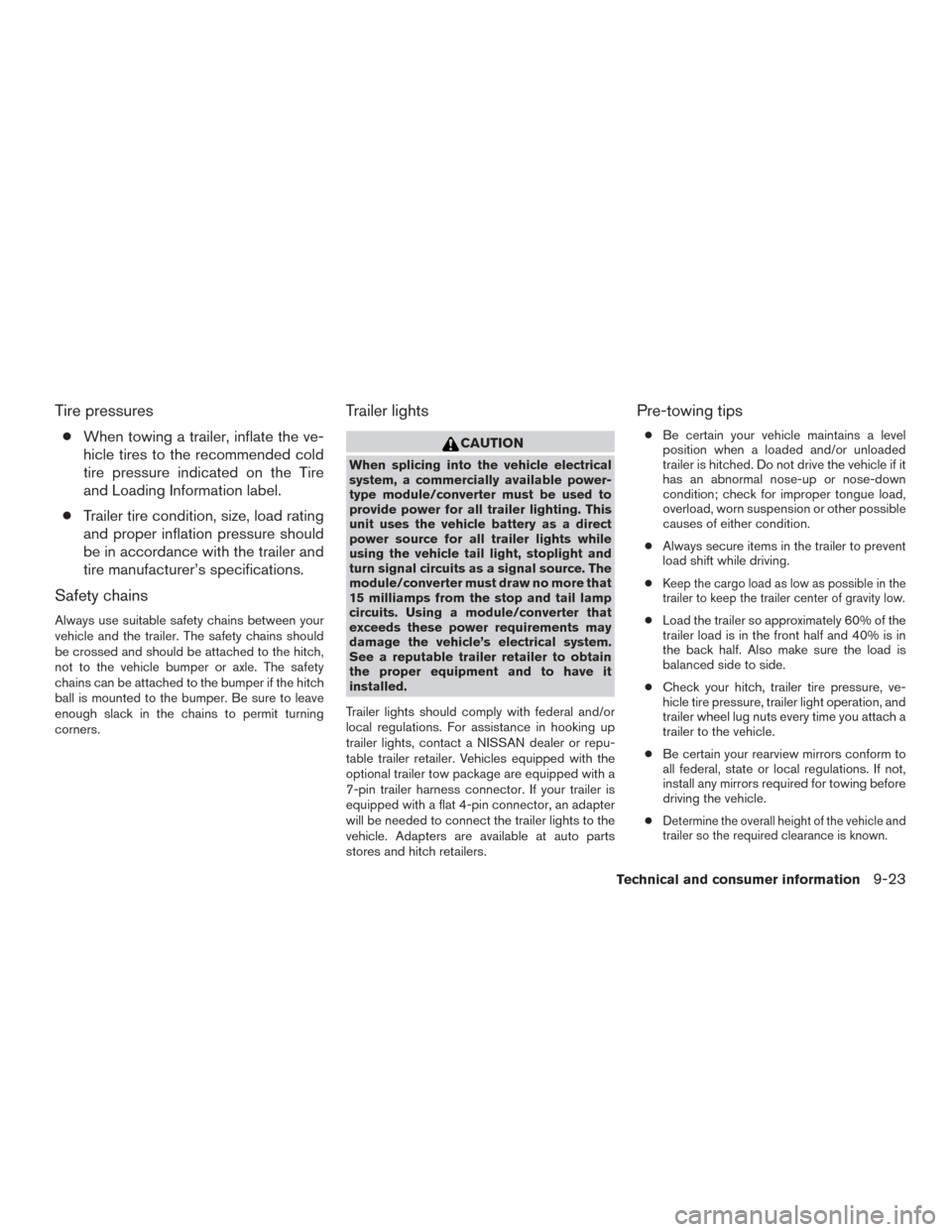
Tire pressures
●When towing a trailer, inflate the ve-
hicle tires to the recommended cold
tire pressure indicated on the Tire
and Loading Information label.
● Trailer tire condition, size, load rating
and proper inflation pressure should
be in accordance with the trailer and
tire manufacturer’s specifications.
Safety chains
Always use suitable safety chains between your
vehicle and the trailer. The safety chains should
be crossed and should be attached to the hitch,
not to the vehicle bumper or axle. The safety
chains can be attached to the bumper if the hitch
ball is mounted to the bumper. Be sure to leave
enough slack in the chains to permit turning
corners.
Trailer lights
CAUTION
When splicing into the vehicle electrical
system, a commercially available power-
type module/converter must be used to
provide power for all trailer lighting. This
unit uses the vehicle battery as a direct
power source for all trailer lights while
using the vehicle tail light, stoplight and
turn signal circuits as a signal source. The
module/converter must draw no more that
15 milliamps from the stop and tail lamp
circuits. Using a module/converter that
exceeds these power requirements may
damage the vehicle’s electrical system.
See a reputable trailer retailer to obtain
the proper equipment and to have it
installed.
Trailer lights should comply with federal and/or
local regulations. For assistance in hooking up
trailer lights, contact a NISSAN dealer or repu-
table trailer retailer. Vehicles equipped with the
optional trailer tow package are equipped with a
7-pin trailer harness connector. If your trailer is
equipped with a flat 4-pin connector, an adapter
will be needed to connect the trailer lights to the
vehicle. Adapters are available at auto parts
stores and hitch retailers.
Pre-towing tips
● Be certain your vehicle maintains a level
position when a loaded and/or unloaded
trailer is hitched. Do not drive the vehicle if it
has an abnormal nose-up or nose-down
condition; check for improper tongue load,
overload, worn suspension or other possible
causes of either condition.
● Always secure items in the trailer to prevent
load shift while driving.
●
Keep the cargo load as low as possible in the
trailer to keep the trailer center of gravity low.
● Load the trailer so approximately 60% of the
trailer load is in the front half and 40% is in
the back half. Also make sure the load is
balanced side to side.
● Check your hitch, trailer tire pressure, ve-
hicle tire pressure, trailer light operation, and
trailer wheel lug nuts every time you attach a
trailer to the vehicle.
● Be certain your rearview mirrors conform to
all federal, state or local regulations. If not,
install any mirrors required for towing before
driving the vehicle.
●
Determine the overall height of the vehicle and
trailer so the required clearance is known.
Technical and consumer information9-23
Page 456 of 478
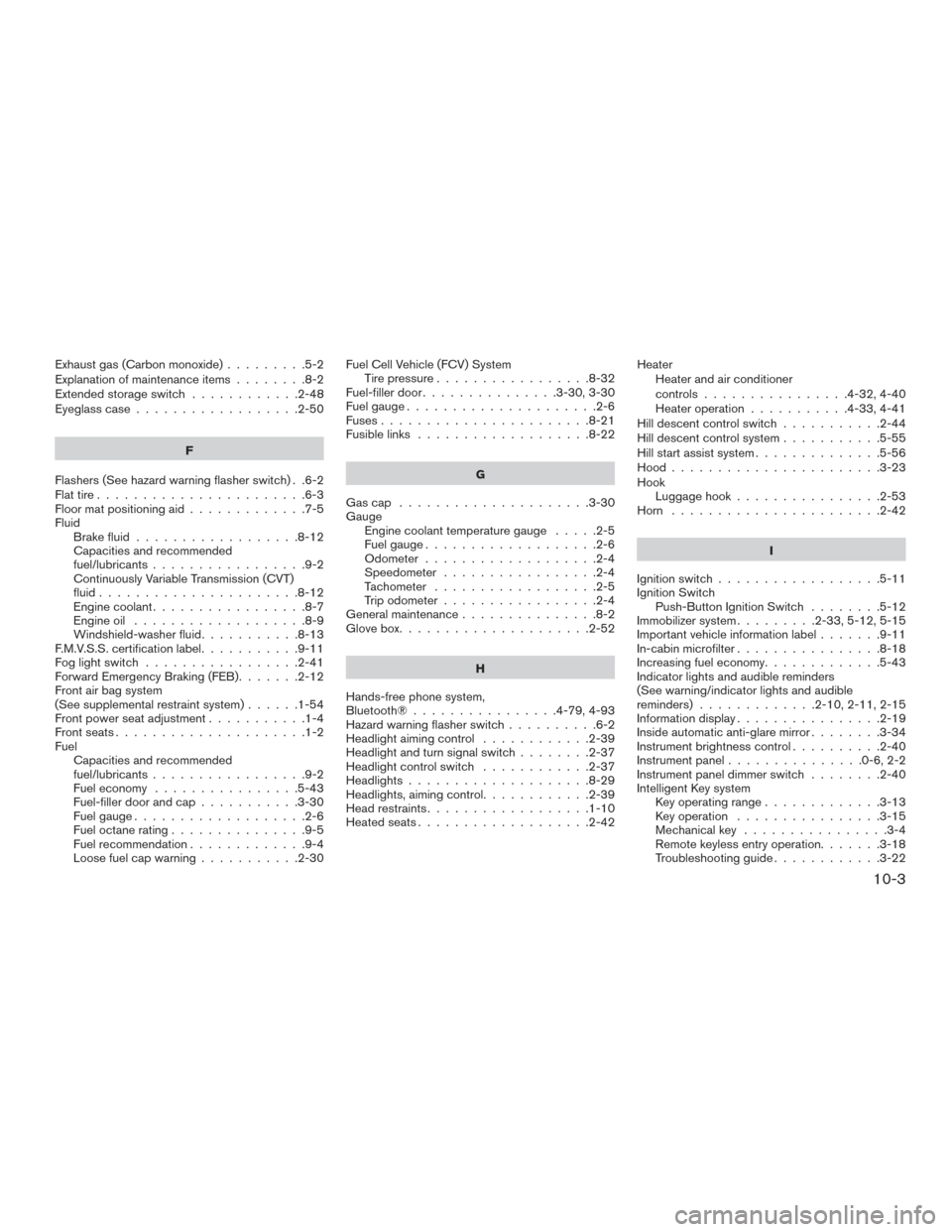
Exhaust gas (Carbon monoxide).........5-2
Explanation of maintenance items ........8-2
Extendedstorageswitch ............2-48
Eyeglass case ..................2-50
F
Flashers (See hazard warning flasher switch) . .6-2
Flat tire .......................6-3
Floor mat positioning aid .............7-5
Fluid Brake fluid ..................8-12
Capacities and recommended
fuel/lubricants .................9-2
Continuously Variable Transmission (CVT)
fluid......................8-12
Engine coolant .................8-7
Engine oil ...................8-9
Windshield-washerfluid...........8-13
F.M.V.S.S. certification label ...........9-11
Foglightswitch .................2-41
Forward Emergency Braking (FEB) .......2-12
Front air bag system
(See supplemental restraint system) ......1-54
Front power seat adjustment ...........1-4
Frontseats.....................1-2
Fuel Capacities and recommended
fuel/lubricants .................9-2
Fuel economy ................5-43
Fuel-filler door and cap ...........3-30
Fuel gauge ...................2-6
Fuel octane rating ...............9-5
Fuel recommendation .............9-4
Loose fuel cap warning ...........2-30 Fuel Cell Vehicle (FCV) System
Tirepressure.................8-32
Fuel-filler door ...............3-30,3-30
Fuelgauge.....................2-6
Fuses.......................8-21
Fusiblelinks ...................8-22
G
Gascap .....................3-30
Gauge Engine coolant temperature gauge .....2-5
Fuel gauge ...................2-6
Odometer ...................2-4
Speedometer .................2-4
Tachometer ..................2-5
Trip odometer .................2-4
General maintenance ...............8-2
Glovebox.....................2-52
H
Hands-free phone system,
Bluetooth®................4-79,4-93
Hazard warning flasher switch ..........6-2
Headlight aiming control ............2-39
Headlight and turn signal switch ........2-37
Headlight control switch ............2-37
Headlights ....................8-29
Headlights, aiming control ............2-39
Head restraints ..................1-10
Heated seats ...................2-42 Heater
Heater and air conditioner
controls ................4-32,4-40
Heater operation ...........4-33,4-41
Hill descent control switch ...........2-44
Hill descent control system ...........5-55
Hill start assist system ..............5-56
Hood.......................3-23
Hook Luggage hook ................2-53
Horn .......................2-42
I
Ignition
switch ..................5-11
Ignition Switch Push-Button Ignition Switch ........5-12
Immobilizer system .........2-33,5-12,5-15
Important vehicle information label .......9-11
In-cabin microfilter ................8-18
Increasing fuel economy .............5-43
Indicator lights and audible reminders
(See warning/indicator lights and audible
reminders).............2-10,2-11,2-15
Information display ................2-19
Inside automatic anti-glare mirror ........3-34
Instrument brightness control ..........2-40
Instrumentpanel...............0-6,2-2
Instrument panel dimmer switch ........2-40
Intelligent Key system Key operating range .............3-13
Key operation ................3-15
Mechanical key ................3-4
Remote keyless entry operation.......3-18
Troubleshooting guide ............3-22
10-3
Page 457 of 478
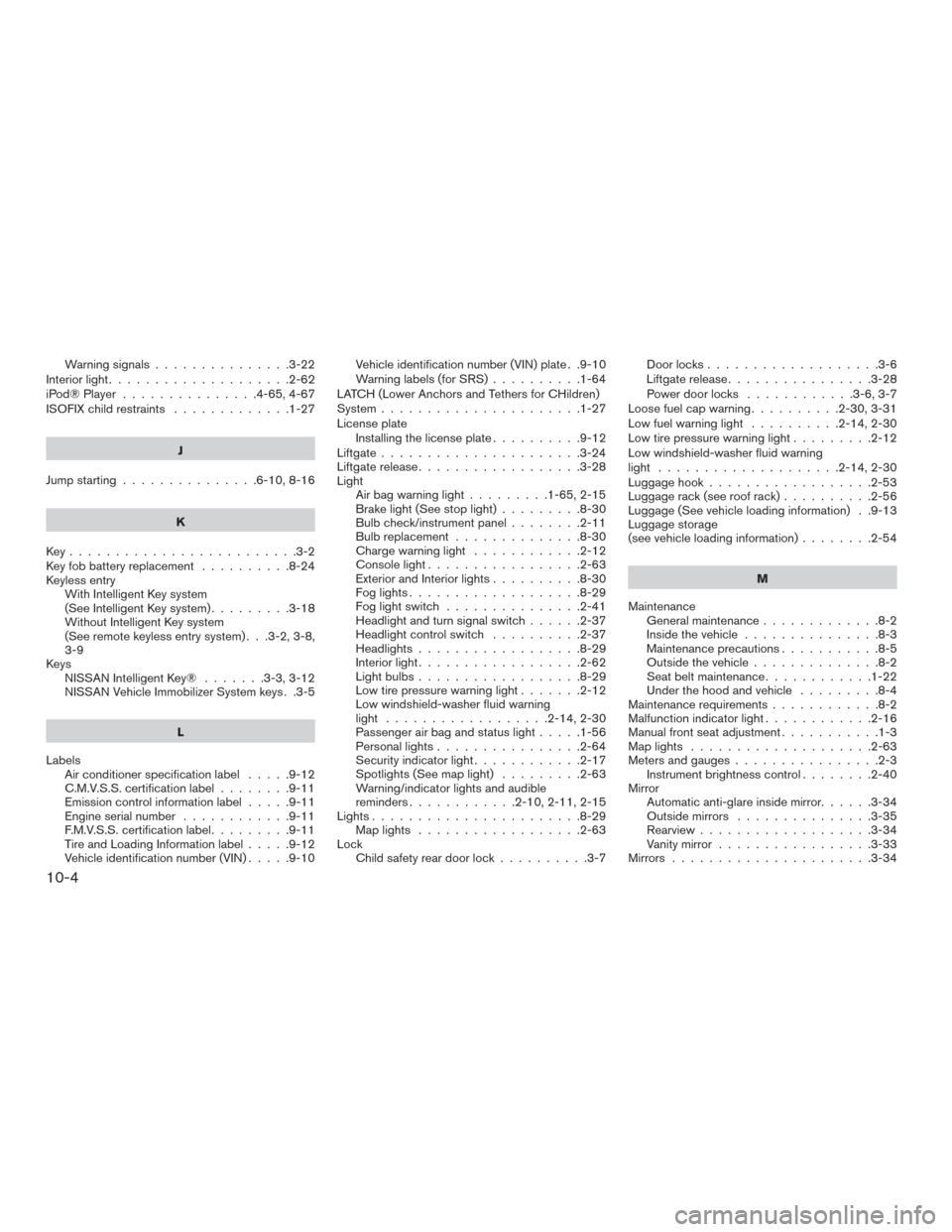
Warning signals...............3-22
Interiorlight....................2-62
iPod®Player ...............4-65,4-67
ISOFIX child restraints .............1-27
J
Jump starting ...............6-10,8-16
K
Key.........................3-2
Key fob battery replacement ..........8-24
Keyless entry With Intelligent Key system
(See Intelligent Key system) .........3-18
Without Intelligent Key system
(See remote keyless entry system) . . .3-2, 3-8,
3-9
Keys NISSAN Intelligent Key® .......3-3,3-12
NISSAN Vehicle Immobilizer System keys . .3-5
L
Labels Air conditioner specification label .....9-12
C.M.V.S.S. certification label ........9-11
Emissioncontrolinformationlabel.....9-11
Engine serial number ............9-11
F.M.V.S.S. certification label .........9-11
Tire and Loading Information label .....9-12
Vehicle identification number (VIN) .....9-10Vehicle identification number (VIN) plate . .9-10
Warning labels (for SRS)
..........1-64
LATCH (Lower Anchors and Tethers for CHildren)
System ......................1-27
License plate Installing the license plate ..........9-12
Liftgate ......................3-24
Liftgate release ..................3-28
Light Air bag warning light .........1-65,2-15
Brake light (See stop light) .........8-30
Bulb check/instrument panel ........2-11
Bulbreplacement..............8-30
Charge warning light ............2-12
Consolelight.................2-63
Exterior and Interior lights ..........8-30
Foglights...................8-29
Foglightswitch ...............2-41
Headlight and turn signal switch ......2-37
Headlight control switch ..........2-37
Headlights..................8-29
Interiorlight..................2-62
Lightbulbs..................8-29
Low tire pressure warning light .......2-12
Low windshield-washer fluid warning
light ..................2-14,2-30
Passenger air bag and status light .....1-56
Personal lights ................2-64
Security indicator light ............2-17
Spotlights(Seemaplight) .........2-63
Warning/indicator lights and audible
reminders ............2-10,2-11,2-15
Lights.......................8-29 Maplights ..................2-63
Lock Child safety rear door lock ..........3-7 Door locks
...................3-6
Liftgate release ................3-28
Power door locks ............3-6,3-7
Loose fuel cap warning ..........2-30,3-31
Low fuel warning light ..........2-14,2-30
Low tire pressure warning light .........2-12
Low windshield-washer fluid warning
light ....................2-14,2-30
Luggage hook ..................2-53
Luggage rack (see roof rack) ..........2-56
Luggage (See vehicle loading information) . .9-13
Luggage storage
(see vehicle loading information) ........2-54
M
Maintenance General maintenance .............8-2
Insidethevehicle...............8-3
Maintenance precautions ...........8-5
Outside the vehicle ..............
8-2
Seat belt maintenance ............1-22
Under the hood and vehicle .........8-4
Maintenance requirements ............8-2
Malfunction indicator light ............2-16
Manual front seat adjustment ...........1-3
Maplights ....................2-63
Meters and gauges ................2-3
Instrument brightness control ........2-40
Mirror Automatic anti-glare inside mirror ......3-34
Outside mirrors ...............3-35
Rearview ...................3-34
Vanity mirror .................3-33
Mirrors ......................3-34
10-4